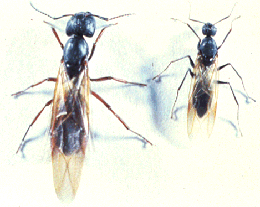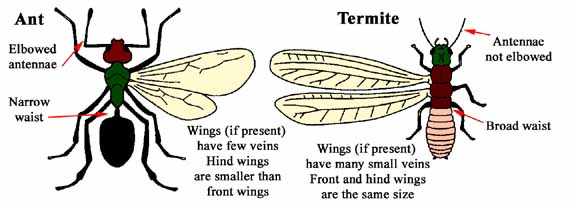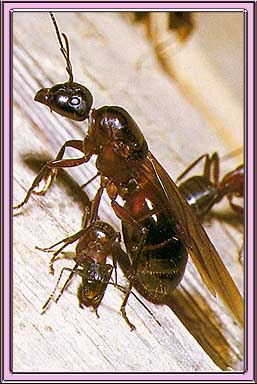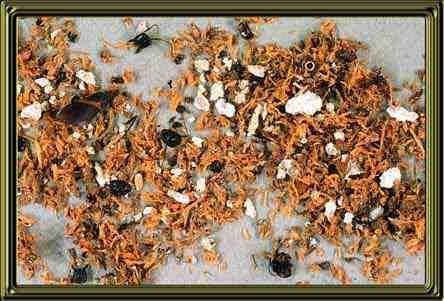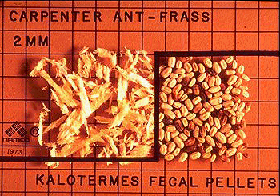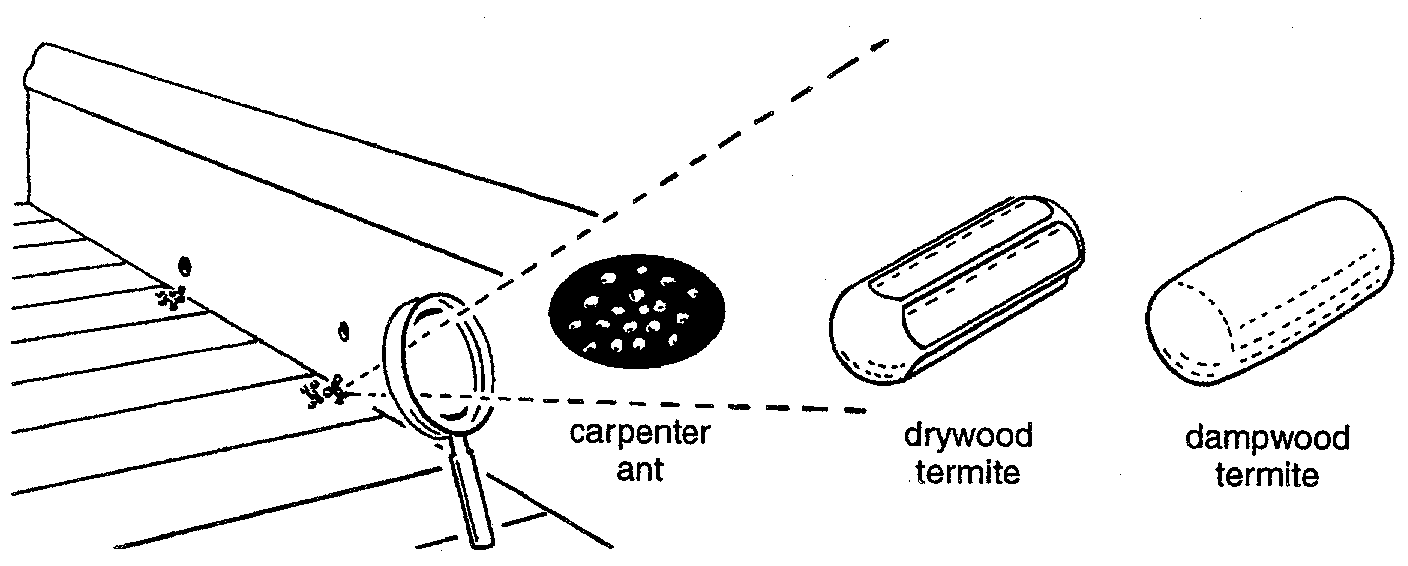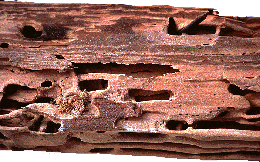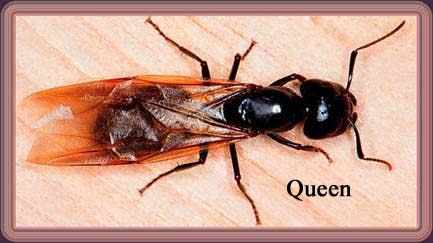
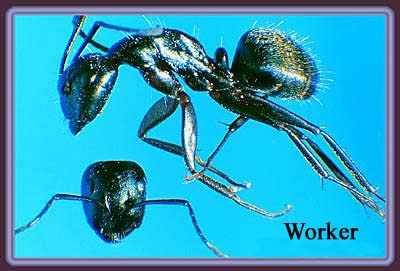
Camponotus pennsylvanicus
(Carpenter Ants)
Characteristics
Life Cycle
Signs of Infestation
Nesting and Feeding Habits
Prevention
Treatment and Control
WARNING
If you haven't already realised by now, I live in the good old U.K. where, we don't suffer from carpenter ants, at least I have never heard of any. But the number of requests I get from the U.S.A. about the problem are many, so I thought that I had better cover the subject in these pages...Characteristics:
Carpenter ants are among the largest species that you will find in the States. Like other ant species, carpenter ants are social, i.e, they live in a colony and have several "castes" or adult forms that perform different jobs in the colony. The queen usually reaches 9/16 inch in length. There are several sizes of workers that range in size from 1/4 to 7/16 inch. All of these ants are adults regardless of their size, but only the queen produces offspring in the nest. Immature ants (larvae) are white, legless, and maggot-looking in appearance. They remain in the nest and are fed by the workers ( which are split in to "major"and "minor"workers ). The larvae develop into pupae, which are tan and capsule-shaped. Eventually, new adults emerge from these pupae. Adult ants will vary in colour depending upon the species. The black carpenter ant (the one we are going to concentrate on), is the species that most commonly nests in homes, and is primarily black in colour. Other carpenter ant species may be more reddish-brown to yellow in colour.Life Cycle:
In the spring, carpenter ants swarm, i.e.,winged adults emerge from the colony. The swarmer's sole purpose is reproduction (after mating he dies). Shortly after mating, the female (queen mated for life) loses her wings and searches out a cavity in wood or soil and each lays 15 to 20 eggs in 15 days.The egg stage takes about 24 days, larval stage 21 days and pupal stage 21 days or about 66 days from egg to adult at 70 to 90 degrees F. Cool weather may lengthen this period up to 10 months. During the first brood, larvae are fed entirely by a fluid secreted from the queen's mouth where she does not take food, but uses stored fat reserves and wing muscles for her nourishment. The few workers emerging from the first brood assume duties of the colony, collecting food, excavating galleries to enlarge the nest and tending the eggs, larvae and pupae of the second generation. Workers regurgitate food for nourishment of the developing larvae and queen. She has few duties except to lay eggs.
In later generations, workers of various sizes are produced (polymorphism) into major and minor workers, that are all sterile females. Larger "major" workers guard the nest, battle intruders, explore and forage for food while smaller "minor" workers expand the nest and care for the young. Workers, when disturbed, carry off the larvae and pupa, which must be fed and tended or they die. After 3-6 years, the colony will contain 2000-3000 workers, and will start to produce swarmers.
The swarmers are actually produced in the autumn, but they wait until the following spring to emerge. In a mature colony, there is usually one queen with 200 to 400 winged individuals produced as swarmers. Workers have strong jaws and readily bite (sharp pinch) when contacted. Swarming is not the only means for carpenter ants to produce new nests. "Satellite" colonies may be formed by workers that move out of the main nest, carrying larvae and pupae with them. Eventually, these secondary colonies produce their own reproductives.
Signs of an Infestation:
There are several indications of an infestation:
Swarmers - The appearance of swarmers indoors is a likely indication of a nest in or under the house (see picture below). Winged ants will emerge from around baseboards, window casings, vents or other openings in floors or walls, and will often congregate around windows. Swarmers found outdoors on porches, siding or around windows are merely a sign of a nearby colony, which is most likely located outdoors. However, it is well worth the effort to inspect your home for other signs of ant activity.
Please excuse the colours in the above drawing...a little bit of artistic licence...but it does show the difference between flying ants and flying termites...OK..!
Workers - Beginning in early spring, worker ants will often be found foraging for water around bathroom/kitchen sinks, dishwashers or showers. Foraging activity is usually greater at night when the lights are off, but you will find ants during the daytime, as well. In some cases, you may be able to trace the insects back outdoors where they are travelling to and from a nearby nest. With extensive foraging, your will find trails that the ants maintain clear of debris. These trails may extend up to 300 feet from the nest.
Camponotus ligniperda (another type of Carpenter ant)
Noise - With mature colonies infesting a house, you can actually hear rustling or gnawing sounds coming from the wood or void where they are nesting.
Sawdust - As the ants expand their nest, they throw out piles of fiber-like wood debris and frass (fecal material). Debris with a dark appearance is likely an indication of decaying wood, and can be used as a clue in searching for the nest. The frass may have a sawdust-like appearance, but will also contains the remnants of ants and other insects on which the colony has been feeding.
The above shows various samples or graphic illustrations of the difference between frass and fecal pellets (which come from termites).
Damage - wood that is damaged by carpenter ants may have slit-like openings through which the ants expel the sawdust and frass (see picture below). The galleries will usually follow the wood grain, with the softer "springwood" portion of the annual rings being excavated first. Tunnels through the harder summerwood connect these galleries. The gallery walls will be relatively smooth, resembling drywood termite damage. However, the galleries of drywood termites are usually filled with small, hard, seed-like fecal pellets that do not resemble the wood fibre debris that carpenter ants remove from their galleries. Wood damaged by subterranean termites also has excavated areas, but the gallery walls have a coating of a mud-like fecal material.
Unlike termites, carpenter ants do not eat wood; they tunnel through wood while building or expanding their nests. Typical outdoor nesting sites include tree holes, tree stumps, logs, standing dead trees, and planter boxes. When conditions are suitable, carpenter ants may establish nests indoors. Typical indoor nesting sites include structural wood, wall voids, attic areas, insulation (foam or fibreglass), hollow doors, window/door casings, voids beneath kitchen/bathroom cabinets, as well as hollow beams (e.g., decorative beams that may cover pipes or girders. In the case of carpenter ant species that nest in existing cavities, the workers may subsequently invade and damage nearby structural wood while expanding their nest site. Looking at the sawn tree and the inside of a stud partition below gives some idea of the damage that can be done.
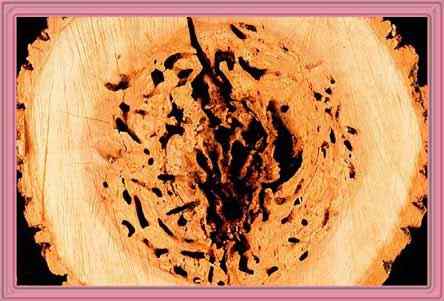
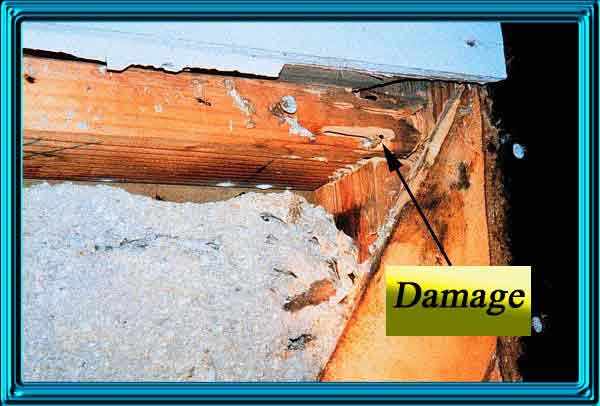
Carpenter ants prefer wood with a moisture content of 15% or higher, so the problem is often associated with moisture. The ants often invade homes through cracks and crevices in the foundation masonry, around windows and doors, through foundation, as well as heating/AC vents. They may travel along tree limbs or shrubs that touch the siding and roof, gaining access to attic and roof space areas. Telephone, electric and cable TV lines also provide ready means of entering the home.
The primary food of carpenter ants is honeydew, the sugary secretions of certain plant-feeding insects, such as aphids and scales. For that reason, worker ants are often found travelling up tree trunks and on to limbs in search of honeydew on the leaves. The ants will also feed on plant secretions and fruit juices, as well on the remains of insects, including dead members of their own colony. When the ants invade homes, they usually seek out sweet items, such as sugar, but they also will feed on fats, grease and meats. Water is also important to the ants. Outdoors, you will often find ants collecting water dripping from water spigots, gutter downspouts or air conditioner drain lines. Indoors, the ants are often seen near sinks, bathtubs and dishwashers.
Anytime there are trees, stumps of trees or other wood items in and around the home, there is always the potential for carpenter ant infestation. However there are important steps that can be taken to prevent carpenter ants from becoming a problem. Prevention starts with common sense and a thorough inspection of the property and NOT with a monthly or whatever period application of gallons of insecticide. It's alright to use insecticide in the correct place at the correct time, but some guys think they have a bottle of "BRUT"and splash it on all over. Proper maintenance of the property and surroundings greatly reduces the risk of infestation. The KEY point to remember is that carpenter ants are usually associated with moisture, particularly where wood is involved.
- Check for moist, soft or rotting structural wood. Pay particular attention to:
a. Attics, roof edges, eaves and gutters.
b. Flashing around chimneys, porch or deck roofs.
c. Porch roofs, railings and columns.
d. Door and window frames.
e. Flat roofs are particularly vulnerable if not maintained properly.- Keep gutters and downspouts clear of debris.
- Repair outdoor water taps/spigots or other plumbing leaks that will definitely attract foraging ants.
- Maintain proper drainage around the property.
- Whenever wood must be in direct contact with soil or masonry (e.g., when installing landscape timbers, porch columns, decking, fencing, etc.), use the correct type of pressure treated timber, sometimes known as tanalised timber.
- Repair cracks to the foundations, these will provide a 14 lane carriageway for ants to gain access, termites as well.
- Keep the crawlspace dry and well ventilated. A properly installed vapour barrier will help.
- Never stack firewood on the porch and deck, or up against the sides of the house itself or the garage (remember they have satellite colonies). Stack firewood up off the ground, it will make inspection easier and will also help prevent rodents from harbouring in this type of area.
- Keep tree limbs and shrubs pruned well back from the property. This will also help prevent damage to the walls and roof, as well as reduce moisture problems, and help keep ants from getting onto the roof, then into the roof space, etc., etc., etc.
- Remove nearby trees which are in poor health or dead or rotting, remember the picture above, the main colony could be in an old tree stump and this colony could splinter into satellite colonies which will travel 300ft.
It is important to remember that finding carpenter ants foraging inside your home does not necessarily mean that they are nesting indoors. Do not panic and do not resort to spraying insecticides indoors where you see ants. Although spraying stops ant foraging for a while, it only serves to detour them elsewhere (possibly elsewhere indoors) and they will likely return when the chemical residue is gone. More importantly, you may be delaying the inevitable discovery that the ants are actually damaging your home. The first step in controlling carpenter ants is to determine if they are nesting indoors. Spraying your foundation with any of the common insecticides, such as chlorpyrifos (Dursban) or diazinon, may keep foraging ants away temporarily, giving you a clue as to the source of the ants. If ant activity continues at about the same level, then you may very well have an indoor infestation. As an alternative to spraying, you can try baiting the ants outdoors. Put small amounts of honey mixed in water into bottle caps and place them along the foundation. Peak carpenter ant activity occurs at night, so check these baits after sunset. Try to track the ants as they move away from the baits and back to their nest. Keep in mind that carpenter ant nests may be as much as 300 feet from where you find foraging ants, so tracking them can be very difficult. The main purpose of this baiting is to see if the ant trail leads. If the ant trails move away from the house, you can use one of the control methods mentioned below for outdoor infestations. If the ants appear to be nesting indoors, the next step is to carefully inspect for likely nesting sites. Concentrate first on those areas around your home that are most vulnerable to moisture problems. Probing the wood with a screwdriver is a good way to uncover damage by a number of wood-destroying pests, including carpenter ants and termites. Careful inspection of the attic and crawlspace are important. Because of the time-consuming and tedious nature of a thorough inspection, you may want to enlist the help of a pest control company that has the experience and the ability to quickly find and eliminate the ants.
Indoor infestations - Ant baits, particularly those containing hydramethylnon, sulfluramid, avermectin or boric acid, can be effective if the ants are foraging for food. If the ants are gathering around water sources (e.g., a sink), they may not be attracted immediately to the bait. In general, baits are the best approach to dealing with ants. They are more effective in the long term and are less hazardous (compared to sprays) when used properly. However, they may require a week or more before ant activity declines. You must be willing to tolerate some ant activity to give the foragers enough time to carry the bait back to the nest where it will be fed to the larvae, other workers and to the queen. Do not spray areas where you will place the bait; otherwise, the ants will avoid these areas and not pick up the bait. If ant activity continues at about the same level for several weeks, then you need to take additional steps to deal with the problem. Before you do any spraying, you should first determine the extent of any structural damage caused by the ants. If the damage is severe, repairing and/or replacing wood (and subsequently removing the nest) may be more important than any treatment, and may solve the problem in the process. If damage is minor, then you can use of a pesticide that is labelled for application to wood to eliminate the nest. Effective control often requires the injection of insecticidal dusts or sprays into voids or into the nest. These treatments are complex and may be too difficult for the average person to carry out safely. Contact a pest control professional for help in these situations.
Outdoor treatments - If the ants are foraging from an outdoor nest, then a perimeter treatment may do the job. Spraying outdoors with Sevin or diazinon along the foundation will cut foraging activity, but does not guarantee that the ants will not return. A better choice is a granular ant bait sprinkled in a 8-12" area on the soil along the foundation. Combat®, which is available in most retail stores, as well as the professional ant baits Maxforce® and Advance® are commonly used for ants, including carpenter ants.
Note: Granular baits are not the same as the granular insecticides (such as Dursban or diazinon) that are often used for controlling lawn pests. Read the product labels carefully to be sure that you buy the right product.
Very Big Note: Any use of insecticide must always be carried out with the utmost caution...You MUST read the label and do what it says...Also be aware that spraying insecticide can kill none target species...And don't forget to wear a mask..!
SourcesUniversity of Florida
University of Kentucky
University of Ohio
The Bug Clinic
